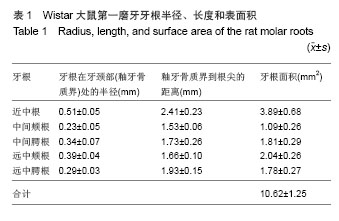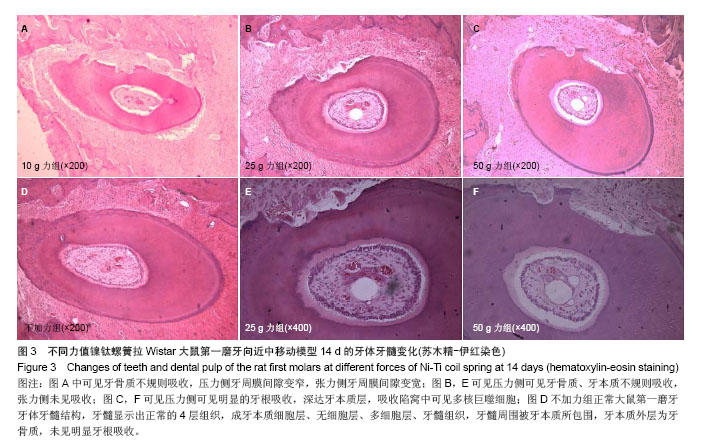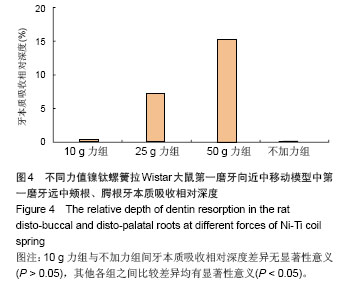| [1]Ribeiro JS,Maciel JV,Knop LA,et al.Effect of growth hormone in experimental tooth movement.Braz Dent J.2013;24(5): 503-507.
[2]Niklas A,Proff P,Gosau M,et al.The Role of Hypoxia in Orthodontic Tooth Movement. Int J Dent.2013;2013:841840.
[3]Li F,Li G,Hu H,et al.Effect of parathyroid hormone on experimental tooth movement in rats.Am J Orthod Dentofacial Orthop.2013;144(4):523-532.
[4]Reitan K,Kvam E.Comparative behavior of human and animal tissue during experimental tooth movement.Angle Orthodontist. 1971;41(1):1-14.
[5]Romanos GE,Bernimoulin JP.Collagen as a basic element of the periodontium: immunohistochemical aspects in the human and animal. 1. Gingiva and alveolar bone. Parodontol.1990; 1(4):363-375.
[6]解志强,白玉兴,王邦康.小型猪正畸牙根吸收实验动物模型的建立[J].北京口腔医学, 2004,12(1):22-26.
[7]Goulart CS,Nouer PRA,Martins LM,et al.Photoradiation and orthodontic movement: experimental study with canines.Photomed Laser Surg.2006;24(2):192-196.
[8]孙新华,王锐,张晓英.He-Ne激光对兔实验性牙移动牙周组织中TGF-β1 表达的影响[J].上海口腔医学,2006,15(1):52-57.
[9]付鼎,厉松,马玉洁,刘鹏飞.上颌快速扩弓对小型猪后牙颊侧骨板改建影响的锥体束CT研究[J].中华口腔正畸学杂志,2013, 20(1): 8-12.
[10]徐芸.口腔正畸学-现代原理与技术[M].天津:科技翻译出版公司, 1996.
[11]Kirschneck C,Proff P,Fanghaenel J,et al.Differentiated analysis of orthodontic tooth movement in rats with an improved rat model and three-dimensional imaging. Ann Anat. 2013;195(6):539-553.
[12]Kaipatur NR,Wu Y,Adeeb S,et al.Impact of bisphosphonate drug burden in alveolar bone during orthodontic tooth movement in a rat model: a pilot study. Am J Orthod Dentofacial Orthop.2013;144(4):557-567.
[13]Ren Y, Maltha JC, Van 't Hof MA,et al.Age Effect on Orthodontic Tooth Movement in Rats.J Dent Res.2003; 82(1): 38-42.
[14]Kersey ML,Glover KE,Heo G,et al. A comparison of dynamic and static testing of latex and nonlatex orthodontic elastics. Angle Orthod.2003;73(2):181-186.
[15]Kim KH,Chung CH,Choy K,et al.Effects of prestretching on force degradation of synthetic elastomeric chains.Am J Orthod Dentofacial Orthop. 2005;128(4):477-482.
[16]Renick MR,Brantley WA,Beck FM,et al.Studies of orthodontic elastomeric modules. Part 1: glass transition temperatures for representative pigmented products in the as-received condition and after orthodontic use.Am J Orthod Dentofacial Orthop.2004;126(3):337-343.
[17]Boshart BF,Currier GF,Nanda RS,et al.Load-deflection rate measurements of activated open and closed coil springs. Angle Orthod.1990;60(1):27-32.
[18]Manhartsberger C,Seidenbusch W.Force delivery of Ni-Ti coil springs. Am J Orthod Dentofac Orthop.1996;109(1):8-21.
[19]Smith NR.Clinical pearl: a method of controlled movement of teeth using open and closed coil spring. J Orthod. 2007;34(3): 173-175.
[20]Han S,Quick DC.Nickel-titanium spring properties in a simulated oral environment.Angle Orthod.1993;63(1):67-72.
[21]Gonzales C,Hotokezaka H,Yoshimatsu M,et al.Force magnitude and duration effects on amount of tooth movement and root resorption in the rat molar.Angle Orthod.2008;78(3): 502-509.
[22]Ren Y,Maltha JC,Kuijpers-Jagtman AM.The rat as a model for orthodontic tooth movement--a critical review and a proposed solution.Eur J Orthod. 2004;26(5):483-490.
[23]魏治统,杜传诗,吴德全.牙周膜面积的测量[J].中华口腔科杂志, 1964,10(1):9-12.
[24]Begg PR,Kesling PC.The differential force method of orthodontic treatment.Am J Orthod.1977;71(1):1-39.
[25]Abi-Ramia LB,Sasso Stuani A,Sasso Stuani MB,et al.Effects of low-level laser therapy and orthodontic tooth movement on dental pulps in rats.Angle Orthod. 2010;80(1):116122.
[26]Ballard DJ,Jones AS,Petocz P,et al.Physical properties of root cementum: part 11. Continuous vs intermittent controlled orthodontic forces on root resorption. A microcomputed- tomography study.Am J Orthod Dentofacial Orthop. 2009; 136(1):8.e1-8; discussion 8-9.
[27]Weltman B,Vig KW,Fields HW.Root resorption associated with orthodontic tooth movement: a systematic review.Am J Orthod Dentofacial Orthop. 2010;137(4):462-476.
[28]Hartsfield JK Jr.Pathways in external apical root resorption associated with orthodontia.Orthod Craniofac Res.2009;12(3): 236-242.
[29]Brezniak N,Wasserstein A.Orthodontically induced inflammatory root resorption. Part I: The basic science aspects. Angle Orthod.2002;72(2):175-179.
[30]Moskovitz M,Tickotsky N,Ashkar H,et al.Degree of root resorption after root canal treatment with iodoform-containing filling material in primary molars. Quintessence Int.2012;43(5): 361-368.
[31]李新桂,刘月华,张寅.正畸力对大鼠正畸牙根吸收后早期修复的影响[J].临床口腔医学杂志,2010,26(2):86-89.
[32]李文星,刘月华.大鼠正畸牙根吸收早期龈沟液中DPP的变化规律[J].临床口腔医学杂志, 2011,27(1):23-26.
[33]王峰,刘志峰,陆怀秀,等.淫羊藿苷对正畸快速扩弓致大鼠牙根吸收抑制作用的扫描电镜观察[J].牙体牙髓牙周病学杂志,2013, 23(11):685-687,712.
[34]Noda K,Arai C,Nakamura Y.Root resorption after experimental tooth movement using superelastic forces in the rat.Eur J Orthod.2010;32(6):681-687. |



.jpg)
.jpg)
.jpg)